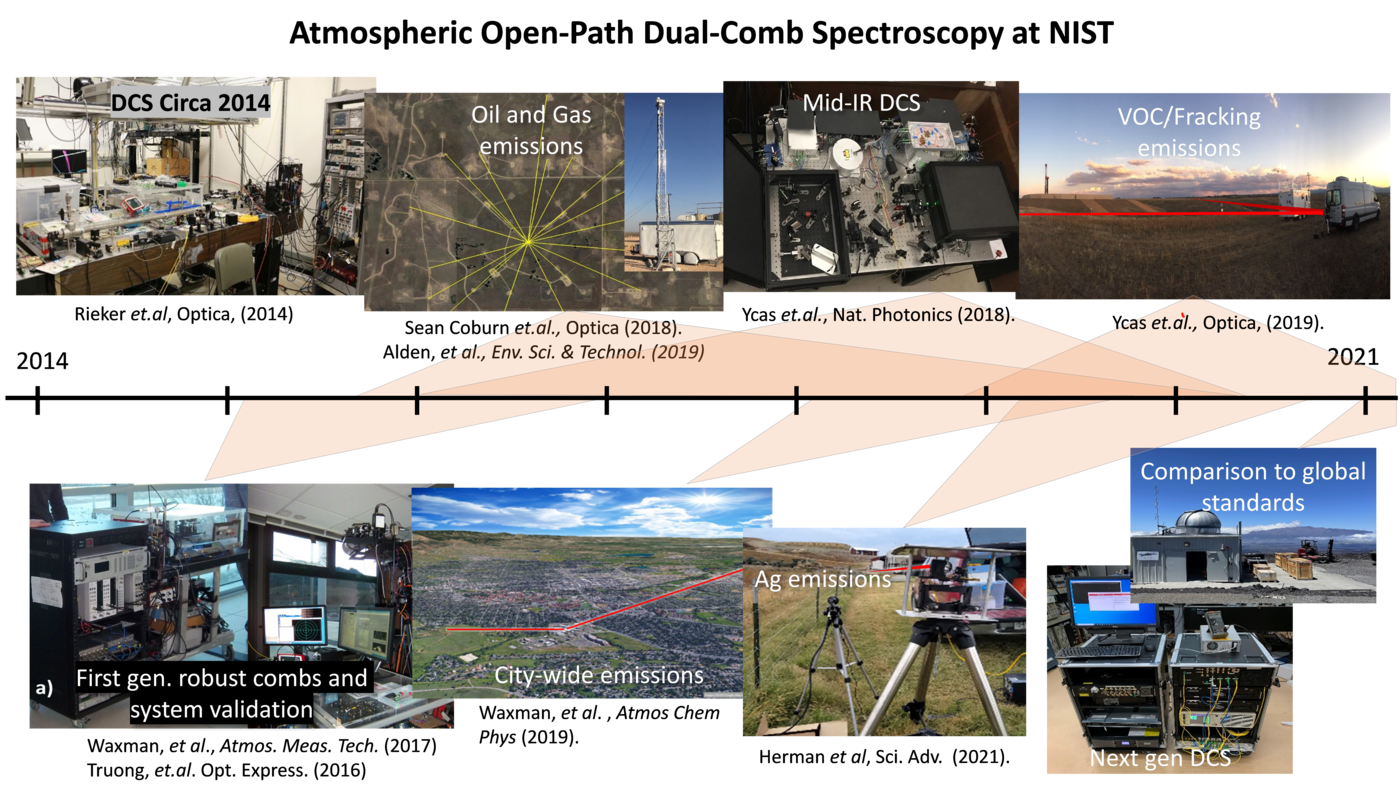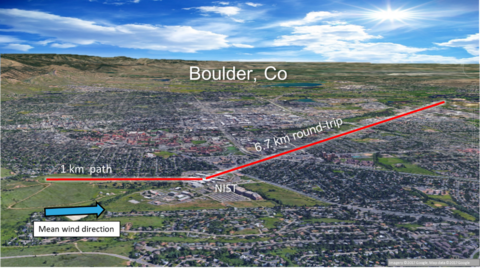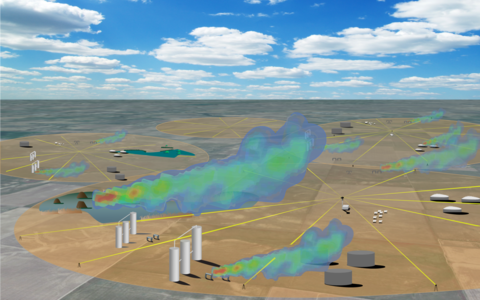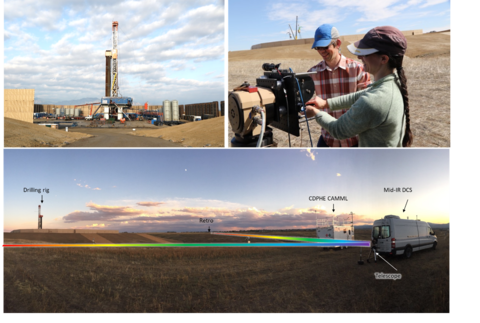Summary
Recent advances in dual-comb spectroscopy enable new opportunities in accurate and precise open-path atmospheric sensing of multiple atmospheric gases critical to climate change and air quality.
Description
Dealing with climate change will require continued reductions in emissions, which in turn will require higher accuracies and precisions for monitoring, reporting and verification. Better monitoring will accelerate local emission reductions as well as being critical to verifying international agreements and rapidly identifying failing solutions. Many greenhouse gas and pollutant sources are distributed over large areas and thus are better suited to monitoring by long open path sensing. Open-path dual-comb spectroscopy should enable new opportunities in accurate and precise open-path atmospheric sensing of a variety of atmospheric constituents critical to climate change and air quality.
Advanced climate monitoring will impact multiple economic sectors critical to national security. For instance, agriculture is a large driver in climate change but must also double food production in the next thirty years to maintain global food security, while coping with the effects of climate change. Monitoring can enable more efficient application of fertilizer and water resources, reducing greenhouse gas (GHG) emissions and resource consumption. Oil and gas production is a source of both methane and ozone-producing volatile organic compounds (VOCs) but important to the near-term energy security of the country. Natural gas can serve as a transitional fuel from coal but rapidly identifying fugitive methane emissions will be needed to mitigate climate change impacts. Urban areas are one of the leading sources of greenhouse gases and are therefore at the forefront of efforts to reduce emissions, but it is challenging to verify any reduction from inventories alone. Satellites can provide worldwide coverage but only if they can be calibrated to unprecedented accuracies. Finally, future geo-engineering will require exquisite monitoring of atmospheric traces gases to avoid unintended impacts.

Greenhouse gas monitoring at urban sites

Measurements of greenhouse gases, especially carbon dioxide (CO2) and methane (CH4), are critical for monitoring, verification, and reporting as countries and cities work towards decreasing their carbon emissions. Measurements on the city-scale are critical because cities contribute to a large fraction of global emissions. However, quantification of city greenhouse gas emissions is challenging, especially for carbon dioxide since it has a high background and numerous point and diffuse sources including traffic, power plants, and animal and plant respiration. Emissions of pollutants are typically determined using two methods: a top-down approach using atmospheric measurements over a specific site or area to adjust a prior model, and bottom-up inventories that calculate emissions based on sector activity and sector emissions factors. Dual-comb spectroscopy (DCS) is a new technique for top-down measurements that uses an open-path sensor rather than a point sensor. The high resolution and negligible instrument lineshape of DCS allows for simultaneous measurements of multiple species and path-integrated temperature with low systematic uncertainty and without the need for instrument calibration. Additionally, the eye-safe, high-brightness, single transverse-mode output of a frequency comb allows for beam paths exceeding 10 km while the speed and parallelism of the measurement suppress any spectral distortion from the inevitable turbulence-induced power fluctuations over such a path. As a first demonstration, we measured carbon dioxide emitted by the city of Boulder Colorado due primarily to traffic. By coupling the measured concentrations with a Gaussian plume model, we were able to estimate the carbon dioxide emissions in reasonable agreement with the City of Boulder inventory. Future work would seek to extend DCS to provide a larger spatial and temporal fraction of the full city emissions as well as develop more sophisticated modeling combined with a more detailed inventory.
Agricultural sites (greenhouse gases, nitrogen emissions)

In partnership with Kansas State University, we have begun applying frequency comb measurements to agriculture emissions. The U.N. estimates that global livestock emission represents 14% of all anthropogenic GHG emissions. It is possible that changes in animal diet or industry practices could reduce these emissions but, as with any system, monitoring and feedback will be critical to guiding any of these processes. Carbon trading programs are also starting to emerge in agriculture and efficient verification of emissions will be an important part of any such program.
In 2019 NIST researchers deployed an open-path dual-comb spectrometer system at a feedlot in Manhattan, Kansas. Using a single near-infrared dual-comb spectrometer we were able to accurately measure concentrations of methane, water, ammonia and carbon dioxide. By combining these concentrations with wind information in a micro-meteorological model, we determined feedlot emissions with hourly time resolution.
It is also important that the system was able to retrieve ammonia as well as methane. Ammonia emitted from livestock production can significantly impact local air quality. Unfortunately, accurately measuring ammonia concentrations is hard for many point sensors because the gas can be “sticky” causing problems at the inlet of these systems; an open path measurement such as dual-comb spectroscopy are immune to these issues. Additionally, recent improvements in mid-infrared dual-comb spectrometers (see Dual-Comb Spectroscopy project) allow for open path measurements of nitrous oxide as well. Measurements that track both nitrous oxide and ammonia could provide important insights into the nitrogen cycle. Such measurements could be used to identify over fertilized regions in cropland, possibly allowing farmers to limit fertilizer costs while also limiting greenhouse gas emissions and water supply contamination associated with over fertilization.
Methane monitoring at oil/gas fields

Methane is generally considered to be the second most critical greenhouse gas and is estimated to be responsible for approximately half the radiative forcing of carbon dioxide. Recently methane has garnered considerable attention in part because of its relatively short atmospheric lifetime compared to carbon dioxide and the observation that a significant reduction in atmospheric methane levels could effectively reduce near-term warming and allow more margin to deal with carbon dioxide emissions. Unfortunately, global methane levels are climbing. Global methane emissions from human activities have reached parity with natural sources.
In the United States one of the most rapidly growing sources of methane emission is the oil and gas sector. Unconventional drilling techniques have spurred significant growth in this industry over the last decade, generating jobs and greatly increasing our energy independence. However, the infrastructure created in this boom does leak natural gas equivalent to a few precent of the total gas produced. Methane is of course the principal component of natural gas and such leaks can have a significant impact on global warming, in addition to negatively impacting efficiency, safety and local air quality.
In 2014, our group began a partnership with Greg Rieker at the University of Colorado to apply dual-comb spectroscopic techniques, developed at NIST, for cost-effective methane leak detection and quantification. The idea was to leverage the high precision possible with dual-comb spectroscopy to see a small amount of methane enhancement from a long way away. This program has been highly successful and ultimately led the formation of LongPath Technologies. See The Long Road from Nobelists' Invention to LongPath Technologies | NIST for a discussion of this effort.
Emissions from fracking sites

As mentioned above, unconventional drilling techniques have spurred significant growth in this industry over the last decade. However, in addition to methane, these techniques can lead to emissions of other hydrocarbons. To this end, we have begun an effort to apply open-path dual-comb spectroscopy to the detection and quantification of the volatile organic compounds (VOCs) that might be emitted from a hydraulic fracturing (fracking) site. Technologically, this is a significantly more challenging problem than detecting methane for several reasons. First, the VOCs are not detectable in the near infrared spectral region but rather require the mid-infrared spectral region. Development and field operation of a mid-infrared dual-comb spectrometer is significantly more challenging (see Frequency-comb-based Spectroscopy (Dual-Comb Spectroscopy)). Second, the signature of the VOCs is much less distinct than that of methane and so the spectral processing of the data is significantly more challenging. Third, quantification of the emissions requires coupling the data to some sort of plume model to “invert” the data – basically to estimate the source strength based on the downwind VOC concentrations. To begin to address this problem, we deployed a first-generation mid-infrared dual comb spectrometer at a local hydraulic fracturing site and observed emission during multiple stages of the extraction processes, including drilling, fracking, mill out and production. In future, the hope is such systems could be deployed middle of a gas play as was done with near-IR systems in partnership with the University of Colorado. Alternatively, the system is portable enough to be deployed by vehicle as shown here or could be stationed and could even be combined with UAS systems to dynamically search for emissions.
Additional Links
- https://www.scientificamerican.com/article/combing-the-atmosphere-with-…
- https://physics.aps.org/articles/v13/92
- https://www.osa-opn.org/home/newsroom/2021/april/agricomb_measures_meth…
- https://centered.tech/gas-measuring-agricomb-could-help-cattle-farms-cu…
- https://academictimes.com/lasers-could-provide-better-measurements-of-m…
- https://arstechnica.com/science/2021/05/agricomb-is-the-perfect-tool-fo…
- https://www.natureworldnews.com/articles/45938/20210505/agricomb-is-the…
- https://cen.acs.org/environment/greenhouse-gases/Taking-moo-surements-l…

